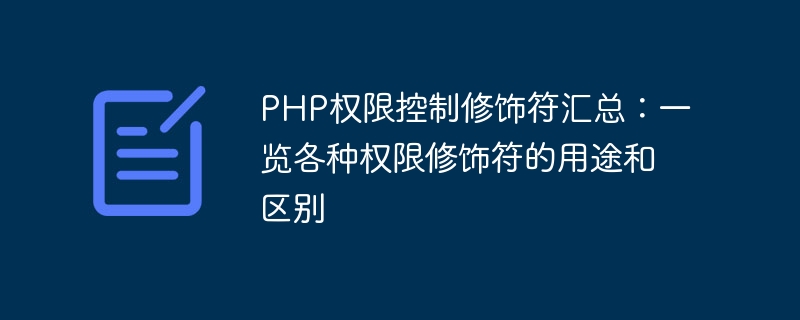

As a programming language commonly used for web development, PHP also has strict requirements for permission management. In order to ensure the security of the program, developers must control permissions on various parts of the program through permission control modifiers. This article will introduce the permission control modifiers in PHP in detail, help readers better understand their functions and differences, and provide corresponding code examples.
The public modifier is the most commonly used permission control modifier in PHP, used to describe public member variables and member methods. Defining a member variable or method as public allows any object to access the variable or method.
For example, the following code example defines a class named Person, and defines a public member variable $name and a public member method sayHello(). Whether accessing these members inside or outside the class does not require any restrictions:
class Person {
public $name;
public function sayHello() {
echo 'Hello, my name is '.$this->name;
}
}
$person = new Person();
$person->name = 'Tom';
$person->sayHello();The protected modifier is used to describe protected member variables and member methods. Defining a member variable or method as protected means that only subclasses and parent classes can access these members.
For example, the following code example defines a class named Animal and defines a protected member variable $name and a protected member method getName() in it. Only subclasses and parent classes of the Animal class can access these members:
class Animal {
protected $name;
protected function getName() {
return $this->name;
}
}
class Cat extends Animal {
public function setName($name) {
$this->name = $name;
}
public function sayHello() {
echo 'Hello, I am '.$this->getName();
}
}
$cat = new Cat();
$cat->setName('Tom');
$cat->sayHello();The private modifier is used to describe private member variables and member methods . Defining a member variable or method as private means that only those within the class can access these members.
For example, the following code example defines a class named Person, and defines a private member variable $name and a private member method getName() in it. These members cannot be accessed directly outside the class:
class Person {
private $name;
private function getName() {
return $this->name;
}
public function sayHello() {
echo 'Hello, my name is '.$this->getName();
}
}
$person = new Person();
$person->name = 'Tom'; // 这里会报错
$person->sayHello();The final modifier is used to limit the overriding of classes and methods. Defining a class or method as final means that it cannot be overridden in subclasses.
For example, the following code example defines a class named Animal and defines a final method eat() in it. Since the method is defined as final, it cannot be overridden in a subclass of Animal:
class Animal {
final public function eat() {
echo 'I am eating';
}
}
class Cat extends Animal {
public function eat() { // 这里会报错
echo 'I am not eating';
}
}
$cat = new Cat();
$cat->eat();abstract modifier is used to define abstraction Classes and abstract methods. Abstract classes cannot be instantiated and can only be inherited by other classes. Abstract methods only have definitions, no specific implementations, and must be overridden in subclasses.
For example, the following code example defines an abstract class named Animal and defines an abstract method eat() in it. Since the eat() method is abstract, this method must be implemented in the Animal subclass Cat:
abstract class Animal {
abstract public function eat();
}
class Cat extends Animal {
public function eat() {
echo 'I am eating fish';
}
}
$cat = new Cat();
$cat->eat();Through the above introduction, we can clearly understand the various permission control modifiers in PHP Uses and differences. When we are developing projects, we need to choose appropriate permission control methods based on specific needs and strictly abide by relevant regulations to ensure the safety and stability of program operation.
The above is the detailed content of Summary of PHP permission control modifiers: an overview of the uses and differences of various permission modifiers. For more information, please follow other related articles on the PHP Chinese website!
 The difference between static web pages and dynamic web pages
The difference between static web pages and dynamic web pages
 What is the difference between 4g and 5g mobile phones?
What is the difference between 4g and 5g mobile phones?
 The difference between k8s and docker
The difference between k8s and docker
 The difference between JD.com's self-operated flagship store and its official flagship store
The difference between JD.com's self-operated flagship store and its official flagship store
 What are the network security technologies?
What are the network security technologies?
 What are the main differences between linux and windows
What are the main differences between linux and windows
 How to implement jsp paging function
How to implement jsp paging function
 How to create a web page in python
How to create a web page in python




